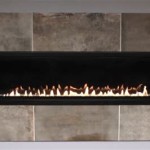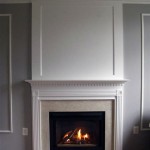Contemporary Gas Fireplace Design: A Deep Dive
Contemporary gas fireplace design represents a significant departure from traditional wood-burning fireplaces, embracing sleek aesthetics, enhanced efficiency, and user-friendly operation. The advancements in technology and materials have allowed for a diverse range of design possibilities, catering to various architectural styles and personal preferences. This article explores the key aspects of contemporary gas fireplace design, discussing the elements that contribute to their modern appeal and functionality.
One of the primary drivers behind the popularity of contemporary gas fireplaces is their convenience. Unlike wood-burning fireplaces that require manual labor for fuel sourcing, loading, and cleaning, gas fireplaces offer instant ignition and adjustable flame heights with the simple push of a button or the flick of a switch. This ease of use makes them a desirable option for homeowners seeking ambiance and supplemental heat without the hassle associated with solid fuel combustion.
Furthermore, contemporary gas fireplaces are designed with energy efficiency in mind. Modern models often incorporate features such as sealed combustion systems, which draw air from outside the home for combustion, minimizing heat loss and preventing drafts. Electronic ignition systems also eliminate the need for a constantly burning pilot light, further reducing energy consumption and improving overall efficiency.
Aesthetics and Design Flexibility
The aesthetic versatility of contemporary gas fireplaces is a major contributing factor to their widespread appeal. They can be seamlessly integrated into a variety of interior design schemes, ranging from minimalist and modern to transitional and even traditional. The design options are virtually limitless, allowing homeowners to customize their fireplace to perfectly complement their existing décor.
One prominent trend is the use of linear fireplaces, which feature elongated designs that create a dramatic focal point in a room. These fireplaces often span significant portions of a wall, creating a visually striking and modern look. Linear fireplaces are available in various lengths and configurations, allowing for customization to suit different room sizes and layouts.
Frameless fireplaces, also known as clean-face fireplaces, are another popular choice in contemporary design. These fireplaces eliminate the traditional surround or mantel, creating a seamless and minimalist appearance. The fire appears to emerge directly from the wall, enhancing the sense of openness and creating a visually uncluttered aesthetic. This style often utilizes materials like smooth stucco, tile, or stone to surround the firebox.
Beyond linear and frameless designs, contemporary gas fireplaces are available in a wide range of shapes and sizes, including corner fireplaces, peninsula fireplaces, and even freestanding models. Corner fireplaces are ideal for maximizing space and creating a focal point in rooms with limited wall space. Peninsula fireplaces, which extend out into the room from a wall, offer a unique design element and can serve as a room divider.
The choice of media used within the firebox also contributes significantly to the aesthetic appeal of contemporary gas fireplaces. Traditional ceramic logs, while still available, are often replaced with more modern alternatives such as glass beads, river stones, or geometric shapes made from ceramic or metal. These media options offer a cleaner, more contemporary look and can be customized to match the overall design scheme.
The use of varying colors within the firebox media is increasingly prevalent. Blues, greens, and reds can be incorporated to provide a unique aesthetic. Modern gas fireplaces also have the ability to change colors of the flame. Lighting is also integrated into the design, to cast light onto the firebox media adding dimension and depth.
Efficiency and Heating Performance
Contemporary gas fireplaces are designed to provide both aesthetic appeal and efficient heating performance. The heating efficiency of a gas fireplace is measured by its Annual Fuel Utilization Efficiency (AFUE) rating. A higher AFUE rating indicates a more efficient fireplace, meaning that a greater percentage of the fuel consumed is converted into usable heat.
Direct-vent gas fireplaces are known for their high efficiency. These fireplaces draw combustion air from outside the home and vent exhaust gases directly to the exterior. This sealed combustion system prevents the loss of heated air from the home and ensures that combustion byproducts are safely vented outside. Direct-vent fireplaces typically have AFUE ratings of 70% or higher.
Vent-free gas fireplaces, also known as ventless fireplaces, do not require a chimney or vent. They operate by burning gas cleanly and efficiently, with minimal emissions. However, vent-free fireplaces are subject to stricter regulations and safety requirements due to the potential for indoor air quality concerns. It's crucial to consult with a qualified professional to ensure that a vent-free fireplace is appropriate for a particular application and that it meets all relevant safety codes.
Many contemporary gas fireplaces are equipped with features such as thermostats and remote controls, allowing homeowners to easily adjust the heat output and maintain a comfortable room temperature. Some models also have programmable timers, which allow users to set the fireplace to turn on and off automatically, further enhancing convenience and energy savings.
The integration of smart home technology is another growing trend in contemporary gas fireplace design. Fireplaces can now be controlled remotely via smartphone apps or voice assistants, allowing users to adjust the flame height, temperature, and other settings from anywhere. This level of control and convenience further enhances the appeal of contemporary gas fireplaces.
Beyond the convenience and efficiency, gas fireplaces can be a reliable source of supplemental heat during power outages. Many gas fireplaces can operate without electricity, relying on battery-powered ignition systems or manual controls. This makes them a valuable asset during emergencies, providing warmth and comfort when other heating systems are unavailable.
Installation and Safety Considerations
Proper installation is crucial for ensuring the safe and efficient operation of a gas fireplace. It is essential to hire a qualified and licensed professional to handle the installation, including the gas line connection, venting system (if applicable), and electrical wiring. Improper installation can lead to gas leaks, carbon monoxide poisoning, and other hazards.
Before installing a gas fireplace, it's important to check local building codes and regulations to ensure compliance. These codes may specify requirements for venting, clearances from combustible materials, and other safety measures. It's also necessary to obtain any required permits before beginning the installation process.
Carbon monoxide detectors should be installed in the home, especially near gas-burning appliances such as fireplaces. Carbon monoxide is a colorless and odorless gas that can be deadly. Carbon monoxide detectors provide an early warning of potentially dangerous levels of the gas.
Regular maintenance is also essential for ensuring the safe and efficient operation of a gas fireplace. This includes cleaning the firebox, inspecting the burner, and checking the venting system for blockages. It's also important to have the fireplace professionally inspected and serviced annually to identify and address any potential issues.
Gas fireplaces should never be used as a primary source of heat. They are designed for supplemental heating and aesthetic purposes. Over-reliance on a gas fireplace for heating can lead to increased energy consumption and potential safety hazards.
Contemporary gas fireplace design offers a blend of aesthetics, efficiency, and convenience that makes them a popular choice for homeowners seeking a modern and stylish heating solution. Their versatility and ease of use contribute to their increasing adoption across various architectural styles. From linear designs to frameless installations, they offer a wide array of options to enhance any living space.

Contemporary Gas Fireplaces Direct Vent By Regency

2024 Gas Fireplace Trends Design Regency

Modern Fireplace Surrounds Top Design Ideas And Inspiration

Spark Modern Fires Contemporary Gas Fireplaces For Luxury Installations

40 Best Gas Fireplace Designs For Stylish Home Ambiance

Gas Fireplaces 6000 Modern Kastle Fireplace

10 Contemporary Gas Fireplace Design Ideas Modus Fireplaces

Gas Fireplace Kalfire Prestige Gp115 75s Bespoke Designs Contemporary Closed Hearth 3 Sided

Contemporary Gas Fireplaces Fireplace And Chimney Authority
Custom Luxury Gas Fireplace Designs Stellar
Related Posts








